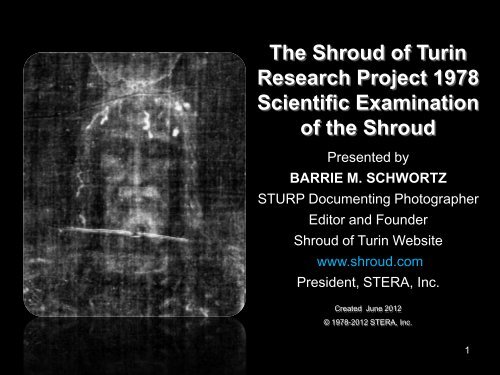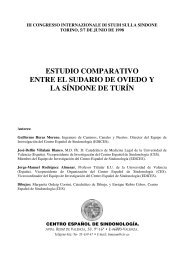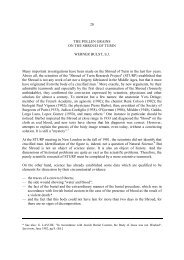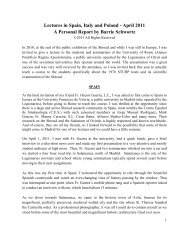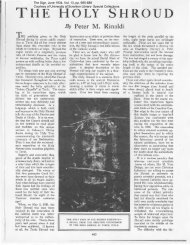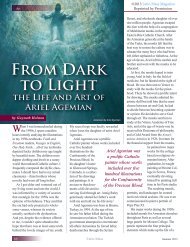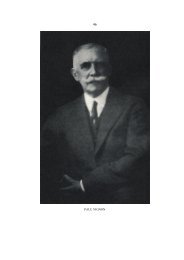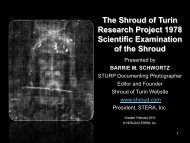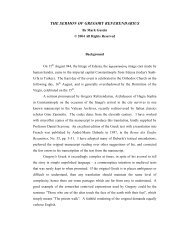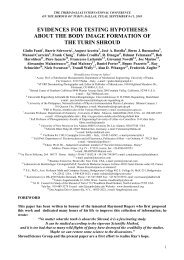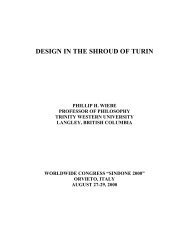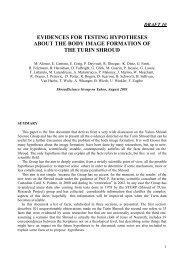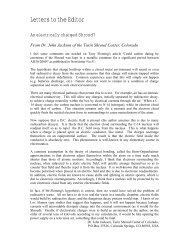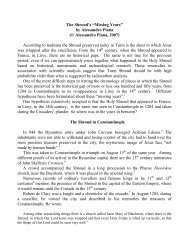The Shroud of Turin Research Project 1978 Scientific Examination ...
The Shroud of Turin Research Project 1978 Scientific Examination ...
The Shroud of Turin Research Project 1978 Scientific Examination ...
You also want an ePaper? Increase the reach of your titles
YUMPU automatically turns print PDFs into web optimized ePapers that Google loves.
<strong>The</strong> <strong>Shroud</strong> <strong>of</strong> <strong>Turin</strong><br />
<strong>Research</strong> <strong>Project</strong> <strong>1978</strong><br />
<strong>Scientific</strong> <strong>Examination</strong><br />
<strong>of</strong> the <strong>Shroud</strong><br />
Presented by<br />
BARRIE M. SCHWORTZ<br />
STURP Documenting Photographer<br />
Editor and Founder<br />
<strong>Shroud</strong> <strong>of</strong> <strong>Turin</strong> Website<br />
www.shroud.com<br />
President, STERA, Inc.<br />
Created June 2012<br />
© <strong>1978</strong>-2012 STERA, Inc.<br />
1
INTRODUCTION<br />
<strong>The</strong> <strong>Shroud</strong> <strong>of</strong> <strong>Turin</strong> <strong>Research</strong> <strong>Project</strong> (STURP) was not the first group<br />
<strong>of</strong> scientists to examine the <strong>Shroud</strong>. <strong>The</strong>re is a long legacy <strong>of</strong> important<br />
<strong>Shroud</strong> scholars and dedicated Sindonologists that came before them.<br />
Without doubt, the first photograph <strong>of</strong> the cloth made by Secondo Pia in<br />
1898 ushered in the scientific era <strong>of</strong> the <strong>Shroud</strong>’s history and prompted<br />
illustrious scholars like Paul Vignon, Pierre Barbet, Msgr. Giulio Ricci,<br />
Don Luigi Fossatti and so many others to take up its serious study in<br />
the first 75 years <strong>of</strong> the 20 th century. We truly owe a huge debt <strong>of</strong><br />
gratitude to these individual pioneers <strong>of</strong> <strong>Shroud</strong> research who paved the<br />
way for modern scientific studies <strong>of</strong> the cloth.<br />
Of course, as a pr<strong>of</strong>essional photographer myself, I was truly honored<br />
to follow in the footsteps <strong>of</strong> Secondo Pia and Giuseppe Enrie, whose<br />
iconic and beautiful 1931 photographs <strong>of</strong> the <strong>Shroud</strong> are famous<br />
worldwide and Giovanni Judica Cordiglia, who made the first color<br />
photographs <strong>of</strong> the cloth in 1969.<br />
2
INTRODUCTION<br />
STURP had the distinction <strong>of</strong> being the first team <strong>of</strong> researchers that,<br />
working together, performed the first ever in-depth, multi-disciplinary<br />
scientific examination <strong>of</strong> the cloth in its history. <strong>The</strong>ir work forms the<br />
primary database <strong>of</strong> credible scientific information about the <strong>Shroud</strong><br />
published in the peer-reviewed scientific literature and has become an<br />
essential resource for the ongoing research done by every serious<br />
<strong>Shroud</strong> scholar in the world today. It is also the perfect starting point for<br />
every new student investigating the science <strong>of</strong> this enigmatic cloth.<br />
In this presentation, I will share with you with my personal perspective<br />
on the STURP team and its history and will do so by using some <strong>of</strong> the<br />
more than 2500 photographs <strong>of</strong> the event I made in my formal capacity<br />
as the Official Documenting Photographer for the project.<br />
So this is not really a scholarly presentation (like the others presented<br />
at this conference), but more accurately, a visual look behind the scenes<br />
<strong>of</strong> an important moment in the history <strong>of</strong> this unique relic.<br />
3
THE BEGINNING<br />
In the 1970’s I operated a commercial photographic studio in Santa Barbara,<br />
California, with clients in the engineering, scientific and medical fields. In<br />
1976, I was asked by Don Devan, a scientist from a local imaging company,<br />
to work with them as a photographic consultant on a project for Los Alamos<br />
National Laboratory.<br />
After seven months we completed the work and I went back to my normal<br />
routine.<br />
4
THE BEGINNING<br />
On February 19, 1976, physicist John Jackson met with William Mottern,<br />
a radiographic expert and researcher working at Sandia Laboratories in<br />
New Mexico. Bill was using a device known as a VP-8 Image Analyzer for<br />
analyzing x-rays in his own research. However, the VP-8 was an image<br />
processing tool that allowed any image to be input via video camera.<br />
So the researchers input a 1931 Enrie photograph <strong>of</strong> the <strong>Shroud</strong> and, by<br />
using the instrument’s ability to convert image density to vertical relief,<br />
were able to visualize on the VP-8’s green screen monitor the rather<br />
amazing natural relief <strong>of</strong> a human form, demonstrating that, completely<br />
unlike normal photographs or artworks, certain spatial or topographic<br />
data was encoded into the <strong>Shroud</strong>’s image.<br />
After sharing the VP-8 results with his colleagues, it was quickly<br />
decided that this warranted further study. Ironically, at about this same<br />
time, Pr<strong>of</strong>. Giovanni Tamburelli in <strong>Turin</strong> was using a computer program<br />
to perform a similar analysis <strong>of</strong> the <strong>Shroud</strong> image.<br />
5
THE BEGINNING<br />
Among the researchers working with Jackson at this same time was<br />
Don Devan, the man from my recently completed Los Alamos project.<br />
Shortly thereafter, I got a call from Don who promptly asked me what I<br />
knew about the <strong>Shroud</strong> <strong>of</strong> <strong>Turin</strong>. Truthfully, I actually laughed out loud<br />
and quickly reminded him that I was Jewish (as was he)! He explained<br />
that some new image properties had been discovered about the <strong>Shroud</strong><br />
and the scientists that made the discovery were putting together a team<br />
<strong>of</strong> researchers that would volunteer their time to examine the cloth and<br />
try to determine how the image was formed. He said that this was to be<br />
a purely scientific effort and that the team was going to need a good<br />
technical photographer. Was I interested<br />
6
THE VP-8 IMAGE ANALYZER<br />
7
THE STURP TEAM GROWS<br />
Thus, the VP-8 Image Analyzer became the catalyst for the formation <strong>of</strong><br />
the STURP team. Jackson’s purpose was very clear: Assemble a team <strong>of</strong><br />
multidisciplinary experts, design a series <strong>of</strong> non-destructive experiments<br />
within the framework <strong>of</strong> a comprehensive test plan and seek permission to<br />
physically examine the <strong>Shroud</strong> itself to try and determine how the image<br />
was formed.<br />
Eric Jumper quickly joined Jackson as co-founder and they began to<br />
recruit experts qualified to conduct scientific experiments that would try<br />
and determine the image formation mechanism <strong>of</strong> the <strong>Shroud</strong>. We were<br />
not trying to prove that the <strong>Shroud</strong> was “authentic” nor were we trying to<br />
prove that the image on the cloth was that <strong>of</strong> Jesus.<br />
Over the next year and a half, the team grew as members were added on<br />
an as-needed basis. We worked in small regional groups around the U.S.<br />
and communicated by telephone and postal mail. We met for the first time<br />
as an entire team only one month before departing for <strong>Turin</strong>.<br />
9
Joseph S. Accetta, Lockheed Corporation*<br />
Steven Baumgart, U.S. Air Force Weapons Laboratories*<br />
John D. German, U.S. Air Force Weapons Laboratories*<br />
Ernest H. Brooks II, Brooks Institute <strong>of</strong> Photography*<br />
Mark Evans, Brooks Institute <strong>of</strong> Photography*<br />
Vernon D. Miller, Brooks Institute <strong>of</strong> Photography*<br />
Robert Bucklin, Harris County, Texas, Medical Examiner's Office<br />
Donald Devan, Oceanographic Services Inc.*<br />
Rudolph J. Dichtl, University <strong>of</strong> Colorado*<br />
Robert Dinegar, Los Alamos National <strong>Scientific</strong> Laboratories*<br />
Donald & Joan Janney, Los Alamos National <strong>Scientific</strong> Laboratories*<br />
J. Ronald London, Los Alamos National <strong>Scientific</strong> Laboratories*<br />
Roger A. Morris, Los Alamos National <strong>Scientific</strong> Laboratories*<br />
Ray Rogers, Los Alamos National <strong>Scientific</strong> Laboratories*<br />
Larry Schwalbe, Los Alamos National <strong>Scientific</strong> Laboratories<br />
Diane Soran, Los Alamos National <strong>Scientific</strong> Laboratories<br />
Kenneth E. Stevenson, IBM*<br />
Al Adler, Western Connecticut State University<br />
Thomas F. D'Muhala, Nuclear Technology Corporation*<br />
Jim Drusik, Los Angeles County Museum<br />
Joseph Gambescia, St. Agnes Medical Center<br />
Roger & Marty Gilbert, Oriel Corporation*<br />
Thomas Haverty, Rocky Mountain <strong>The</strong>rmograph*<br />
John Heller, New England Institute<br />
John P. Jackson, U.S. Air Force Academy*<br />
Eric J. Jumper, U.S. Air Force Academy*<br />
Jean Lorre, Jet Propulsion Laboratory*<br />
Donald J. Lynn, Jet Propulsion Laboratory*<br />
Robert W. Mottern, Sandia Laboratories*<br />
Samuel Pellicori, Santa Barbara <strong>Research</strong> Center*<br />
Barrie M. Schwortz, Barrie Schwortz Studios*<br />
Note: <strong>The</strong> researchers marked with an * participated directly in the <strong>1978</strong> <strong>Examination</strong> in <strong>Turin</strong>.<br />
All others are STURP research members who worked with the data or samples after the team<br />
returned to the United States.<br />
10
THE STURP TEST PLAN<br />
<strong>The</strong> STURP team spent a year and a half<br />
designing a comprehensive battery <strong>of</strong><br />
non-destructive tests that could be<br />
performed in a brief but efficient period<br />
<strong>of</strong> time. <strong>The</strong>y developed the protocols<br />
for each experiment, scheduled the<br />
tests within the confines <strong>of</strong> a 96 hour<br />
test period and compiled everything<br />
into a detailed, 65 page spiral bound<br />
notebook that would not only guide us<br />
during our examination, but would first<br />
be submitted to <strong>Turin</strong> for final approval.<br />
Permission to examine the <strong>Shroud</strong> was<br />
granted to STURP by King Umberto II,<br />
Duke <strong>of</strong> Savoy, the owner <strong>of</strong> the <strong>Shroud</strong><br />
in <strong>1978</strong>. To assist us in our liaison with<br />
the Church and the <strong>Turin</strong> Custodians,<br />
we also worked closely with the Holy<br />
<strong>Shroud</strong> Guild in Esopus, New York.<br />
11
STURP PREPARES FOR TURIN – THE “DRY RUN”<br />
In September <strong>1978</strong>, less than one month before leaving for <strong>Turin</strong>, the entire<br />
team met together for the first time in Amston, Connecticut, at what was<br />
simply referred to as the “Dry Run.”<br />
This allowed all the team members from the different groups to finally meet<br />
in person and more importantly, set up and test their various instruments<br />
(many <strong>of</strong> them custom designed and fabricated specifically for the project)<br />
and rehearse the procedures they would ultimately be using on the <strong>Shroud</strong>.<br />
12
STURP Co-Founder John Jackson<br />
13
STURP chemist Ray Rogers and Fr. Adam Otterbein, Holy <strong>Shroud</strong> Guild<br />
14
Ronald London and William Mottern with their x-ray equipment<br />
15
Joe Accetta and Steve Baumgart set<br />
up their thermographic instruments<br />
16
Don Devan with the <strong>Shroud</strong> <strong>Examination</strong> Table (1 st slide)<br />
and the Replica <strong>Shroud</strong> used by the team at the “Dry Run”<br />
17
STURP team members John Jackson, Don Lynn, Ernest Brooks (l to r) and<br />
Don Devan (far left) place the replica on the <strong>Shroud</strong> <strong>Examination</strong> Table<br />
18
<strong>The</strong> <strong>Shroud</strong> Replica, held in place with magnets at its periphery, is<br />
rotated to a vertical position on the stainless steel <strong>Examination</strong> Table.<br />
You can also see the camera rail system set up in front <strong>of</strong> the <strong>Shroud</strong>.<br />
19
Barrie Schwortz with motorized Hasselblad camera on rail system<br />
20
Don Devan and Don Lynn<br />
21
Vern Miller, Don Devan, Don Lynn and Jean Lorre<br />
22
A LAST MINUTE CRISIS<br />
<strong>The</strong> team was scheduled to depart for <strong>Turin</strong> on September 29, <strong>1978</strong> and the<br />
80 crates filled with our equipment and instruments were shipped to Italy in<br />
advance. <strong>The</strong> plan was to arrive a full week before the end <strong>of</strong> the public<br />
exhibition to allow us ample time to carefully unpack our equipment and set<br />
up and calibrate our scientific instruments.<br />
However, late in the evening <strong>of</strong> September 28 th , the night before we were to<br />
leave, the sad news was announced that Pope John Paul I had died<br />
suddenly in Rome. We were all shocked and frankly, were very concerned<br />
that permission to examine the <strong>Shroud</strong> might now be withheld. But after<br />
many late night phone calls amongst team members, it was decided that we<br />
would proceed as planned and hope for the best. We left the next morning.<br />
23
Informal group portrait <strong>of</strong> the STURP team at Kennedy International Airport - Sept. 29, <strong>1978</strong><br />
24
STURP arrives in Milan, Italy<br />
25
ANOTHER CRISIS<br />
Almost immediately upon our arrival in <strong>Turin</strong> we were informed that all <strong>of</strong> our<br />
equipment and instruments had been seized by Italian Customs <strong>of</strong>ficials and<br />
were being held in quarantine. Apparently, fixed to the outside <strong>of</strong> the crate<br />
that housed the x-ray equipment was a radiation warning sticker. This caused<br />
the <strong>of</strong>ficials such concern that they simply seized everything and refused to<br />
release it!<br />
Needless to say, this caused great concern for the STURP team as well. Over<br />
the next five days we waited while the team leaders and the Italian authorities<br />
tried to find a solution. During that time our days were filled with countless,<br />
tedious meetings and we all were feeling the stress <strong>of</strong> the situation since we<br />
were losing valuable time.<br />
Since the public exhibition was still ongoing, I still had a little time to go out<br />
and do what I do best: make some photographs!<br />
26
Public Exhibition in <strong>Turin</strong><br />
27 August - 8 October <strong>1978</strong><br />
27
Comparing Technologies at the Sindone Museo (Pia’s Camera vs. Nikon)<br />
29
Inside the Royal Palace<br />
30
Fresco in the “Equipment Maintenance” Room<br />
31
Fresco in the <strong>Shroud</strong> <strong>Examination</strong> Room<br />
32
ANOTHER CRISIS AVERTED<br />
(<strong>Turin</strong> Style)<br />
Finally, on the fifth day and with no relief in sight, Fr. Peter Rinaldi <strong>of</strong> the Holy<br />
<strong>Shroud</strong> Guild (who himself was originally from <strong>Turin</strong>), solved the problem <strong>of</strong><br />
our seized equipment by visiting the customs <strong>of</strong>fice personally.<br />
33
<strong>The</strong> equipment arrives at the Royal Palace on a dump truck!<br />
34
“You unload!”<br />
35
“You unload!”<br />
36
Of course, this left STURP with only 1½ days to unpack their equipment<br />
and prepare everything for their experiments. <strong>The</strong> pressure was on!<br />
37
Pr<strong>of</strong>. Luigi Gonella helps unload STURP equipment<br />
38
Ernest Brooks and Vernon Miller<br />
39
Joan and Rudy Dichtl<br />
40
<strong>The</strong> “Equipment Maintenance” Room<br />
41
<strong>The</strong> <strong>Shroud</strong> <strong>Examination</strong> Room<br />
42
Windows are covered with foil for the infrared experiments<br />
43
Vern Miller, Sam Pellicori and Don Devan calibrating camera rail system<br />
44
<strong>The</strong> Team meets in the <strong>Shroud</strong> <strong>Examination</strong> Room<br />
45
“Here comes the <strong>Shroud</strong>!”<br />
46
Our first look at the <strong>Shroud</strong><br />
49
Msgr. Jose Cottino and Pr<strong>of</strong>. Vallauri removing the thumb tacks!<br />
51
Pr<strong>of</strong>. Giovanni Riggi and Eric Jumper<br />
52
Eric Jumper, Msgr. Jose Cottino and Msgr. Sergio Baldi move the <strong>Shroud</strong> to the<br />
STURP <strong>Examination</strong> Table while (l to r in background) Pr<strong>of</strong>essors Gonella,<br />
Baima-Bollone and Riggi observe.<br />
53
Tom D’Muhula, John Jackson and Don Devan moving the <strong>Shroud</strong> to the<br />
STURP <strong>Examination</strong> Table<br />
54
Eric Jumper moving the <strong>Shroud</strong> to the STURP <strong>Examination</strong> Table<br />
55
<strong>The</strong> <strong>Scientific</strong> <strong>Examination</strong><br />
<strong>of</strong> the <strong>Shroud</strong> <strong>of</strong> <strong>Turin</strong><br />
October 8-13, <strong>1978</strong><br />
56
Max Frei was given the privilege <strong>of</strong><br />
starting the examination and began<br />
by taking sticky tape samples from<br />
the <strong>Shroud</strong>, as Ray Rogers, leader <strong>of</strong><br />
STURP’s chemistry group, observes.<br />
57
Max Frei applied commercial sticky<br />
tape to the <strong>Shroud</strong> using his thumb<br />
to control application pressure. Alan<br />
Adler observed years later that the<br />
tape definitely left a gum residue on<br />
the cloth that attracted dirt and dust<br />
wherever it was applied.<br />
58
Frei’s method <strong>of</strong> tape application and<br />
removal also caused considerable<br />
strain on the cloth itself. <strong>The</strong>n, at one<br />
point in his testing, Frei reached over<br />
to place his tape on the <strong>Shroud</strong> face.<br />
59
John Jackson strongly protested to Pr<strong>of</strong>. Luigi Gonella and<br />
ultimately, no tape was placed on the <strong>Shroud</strong> face by anyone<br />
60
Next to examine the <strong>Shroud</strong> was Pr<strong>of</strong>. Giovanni Riggi, who here observes as a<br />
small portion <strong>of</strong> the <strong>Shroud</strong> is unstitched from the Holland Cloth, allowing him<br />
to insert his vacuum and endoscopic camera systems between the two cloths. 61
As the cloths were unstitched, I realized we were about to see the back side<br />
<strong>of</strong> the <strong>Shroud</strong> <strong>of</strong> <strong>Turin</strong> for the first time in nearly 450 years!<br />
62
Ray Rogers, John Jackson and Pr<strong>of</strong>. Giovanni Riggi<br />
63
Pr<strong>of</strong>. Giovanni Riggi & Gabriele Porrati prepare the vacuum and endoscopic tests<br />
64
Pr<strong>of</strong>. Riggi uses a custom made ‘bridge’ to hold the <strong>Shroud</strong> and Holland Cloth<br />
apart so the vacuum & endoscopic camera systems could be inserted between<br />
65
Pr<strong>of</strong>. Giovanni Riggi and his team performing the vacuum experiment<br />
66
Pr<strong>of</strong>. Giovanni Riggi’s Endoscopic Camera Grid (10cm squares)<br />
68
Pr<strong>of</strong>. Giovanni Riggi’s endoscopic camera focusing light transilluminates<br />
the #3 bloodstain on the forehead, revealing higher density in blood areas<br />
69
STURP Begins with Photography<br />
Vern Miller, Chief <strong>Scientific</strong> Photographer and Don Devan, Imaging Specialist<br />
72
Vernon Miller using Hasselblad camera mounted on Camera Support Rail<br />
with rotating wheel mounted in front <strong>of</strong> the lens housing the B/G/R filters<br />
73
Quad Mosaic Images<br />
Courtesy Jean Lorre Collection, STERA, Inc.<br />
74
UV Fluorescence Photograph <strong>of</strong> Spear Wound Bloodstain<br />
Serum Halo _________<br />
Visible Only With<br />
UV Fluorescence<br />
Photography<br />
Courtesy Vernon D. Miller<br />
75
UV Filter Over<br />
Camera Lens<br />
Liquid UV Filters<br />
Over Light<br />
Sources<br />
76
Photomicroscopy<br />
Mark Evans<br />
77
64x Photomicrograph <strong>of</strong> the <strong>Shroud</strong> <strong>of</strong> <strong>Turin</strong> showing Image at tip <strong>of</strong> nose<br />
Courtesy Mark Evans Collection, STERA, Inc.<br />
78
32X Photomicrograph <strong>of</strong> the <strong>Shroud</strong> showing dense blood at the small <strong>of</strong> the back<br />
Courtesy Mark Evans Collection, STERA, Inc.<br />
79
Reflected and<br />
Transmitted Light<br />
Photography<br />
Vernon Miller and Barrie Schwortz<br />
80
Magnets mark the specific test points on the<br />
<strong>Shroud</strong> where the researchers took their data<br />
81
Photographic maps were produced for each experiment. <strong>The</strong>se were created<br />
from the magnetic markers put in place by the researchers at every point<br />
they tested on the <strong>Shroud</strong>.<br />
82
Infrared Reflectance Spectroscopy<br />
Infrared <strong>The</strong>rmography<br />
Infrared Photography<br />
83
Steve Baumgart, Robert Dinegar and Joseph Accetta set up Infrared instruments<br />
84
Joseph Accetta calibrates blackbody radiation source<br />
85
UV Reflectance and<br />
Fluorescence Spectroscopy<br />
Marty Gilbert, Oriel Corporation<br />
86
Roger and Marty Gilbert, Oriel Corporation<br />
87
X-ray Radiography<br />
Ronald London and William Mottern<br />
88
William Mottern and Ronald London remove the steel panels<br />
via the rear <strong>of</strong> the <strong>Shroud</strong> <strong>Examination</strong> Table to allow for<br />
x-rays to be taken <strong>of</strong> the cloth<br />
89
William Mottern waits patiently (without moving his feet)<br />
during one <strong>of</strong> the 20 minute low power x-ray exposures<br />
90
<strong>The</strong> “Darkroom”<br />
91
Ray Rogers, Tom D’Muhula, Bob Dinegar and Fr. Francis Filas<br />
92
X-ray courtesy William Mottern Collection, STERA, Inc.<br />
93
Ray Rogers examines the <strong>Shroud</strong> with a binocular ophthalmic microscope<br />
94
Ray Rogers and Robert Dinegar<br />
used a custom fabricated stainless<br />
steel torque applicator to control<br />
the pressure <strong>of</strong> sticky tape applied<br />
to certain preselected test areas <strong>of</strong><br />
the <strong>Shroud</strong>. This allowed for the<br />
removal <strong>of</strong> surface material for later<br />
chemical and microscopic analysis.<br />
<strong>The</strong> tape was created for STURP by<br />
the 3M Company to have carefully<br />
predetermined optical properties<br />
and was specifically formulated to<br />
leave no gum residue on the cloth.<br />
95
Ray Rogers removes one <strong>of</strong> his<br />
tape samples from the <strong>Shroud</strong>.<br />
Note the magnetic markers he<br />
put in place at each sample site.<br />
96
Custom well slides were fabricated to secure the tape samples by the<br />
edges and prevent any lifted debris from being embedded in the gum<br />
97
Robert Ewing<br />
STURP actually brought a computer with them, but it never worked!<br />
98
CONCLUSIONS OF THE STURP TEAM<br />
...<strong>The</strong> answer to the question <strong>of</strong> how the image was<br />
produced or what produced the image remains, now, as<br />
it has in the past, a mystery.<br />
We can conclude for now that the <strong>Shroud</strong> image is that<br />
<strong>of</strong> a real human form <strong>of</strong> a scourged, crucified man. It is<br />
not the product <strong>of</strong> an artist. <strong>The</strong> blood stains are<br />
composed <strong>of</strong> hemoglobin and also give a positive test<br />
for serum albumin. <strong>The</strong> image is an ongoing mystery<br />
and until further chemical studies are made, perhaps by<br />
this group <strong>of</strong> scientists, or perhaps by some scientists<br />
in the future, the problem remains unsolved.<br />
Summary <strong>of</strong> STURP Final Report - 1981<br />
99
STURP PUBLISHED PAPERS<br />
1. Accetta, J.S. and J.S. Baumgart, "Infrared Reflectance Spectroscopy and <strong>The</strong>rmographic Investigations <strong>of</strong> the <strong>Shroud</strong> <strong>of</strong> <strong>Turin</strong>," Applied Optics, Vol. 19, No.<br />
12, pp. 1921-1929.<br />
2. Avis, C., D. Lynn, J. Lorre, S. Lavoie, J. Clark, E. Armstrong, and J. Addington, "Image Processing <strong>of</strong> the <strong>Shroud</strong> <strong>of</strong> <strong>Turin</strong>," IEEE 1982 Proceedings <strong>of</strong> the<br />
International Conference on Cybernetics and Society, October 1982, pp. 554-558.<br />
3. Devan, D. and V. Miller, "Quantitative Photography <strong>of</strong> the <strong>Shroud</strong> <strong>of</strong> <strong>Turin</strong>," IEEE 1982 Proceedings <strong>of</strong> the International Conference on Cybernetics and<br />
Society, October 1982, pp. 548-553.<br />
4. Ercoline, W.R., R.C. Downs, Jr. and J.P. Jackson, "<strong>Examination</strong> <strong>of</strong> the <strong>Turin</strong> <strong>Shroud</strong> for Image Distortions," IEEE 1982 Proceedings <strong>of</strong> the International<br />
Conference on Cybernetics and Society, October 1982, pp. 576-579.<br />
5. Gilbert, R., Jr. and M.M. Gilbert, "Ultraviolet-Visible Reflectance and Fluorescence Spectra <strong>of</strong> the <strong>Shroud</strong> <strong>of</strong> <strong>Turin</strong>," Applied Optics, Vol. 19, No. 12, pp.<br />
1930-1936.<br />
6. Heller, J.H. and A.D. Adler, "Blood on the <strong>Shroud</strong> <strong>of</strong> <strong>Turin</strong>," Applied Optics, Vol. 19, No. 16, 1980, pp. 2742-2744.<br />
7. Heller, J.H. and A.D. Adler, "A Chemical Investigation <strong>of</strong> the <strong>Shroud</strong> <strong>of</strong> <strong>Turin</strong>," Canadian Society <strong>of</strong> Forensic Sciences Journal, Vol. 14, No. 3, 1981, pp. 81-<br />
103.<br />
8. Jackson, J.P., E.J. Jumper and W.R. Ercoline, "Three Dimensional Characteristic <strong>of</strong> the <strong>Shroud</strong> Image," IEEE 1982 Proceedings <strong>of</strong> the International<br />
Conference on Cybernetics and Society, October 1982, pp. 559-575.<br />
9. Jackson, J.P., E.J. Jumper, and W.R. Ercoline, "Correlation <strong>of</strong> Image Intensity on the <strong>Turin</strong> <strong>Shroud</strong> with the 3-D Structure <strong>of</strong> a Human Body Shape," Applied<br />
Optics, Vol. 23, No. 14, 1984, pp. 2244-2270.<br />
10. Jumper, E.J. and R.W. Mottern, "<strong>Scientific</strong> Investigation <strong>of</strong> the <strong>Shroud</strong> <strong>of</strong> <strong>Turin</strong>," Applied Optics, Vol. 19, No. 12, 1980, pp. 1909-1912.<br />
11. Jumper, E.J., "An Overview <strong>of</strong> the Testing Performed by the <strong>Shroud</strong> <strong>of</strong> <strong>Turin</strong> <strong>Research</strong> <strong>Project</strong> with a Summary <strong>of</strong> Results," IEEE 1982 Proceedings <strong>of</strong> the<br />
International Conference on Cybernetics and Society, October 1982, pp. 535-537.<br />
12. Jumper, E.J., A.D. Adler, J.P. Jackson, S.F. Pellicori, J.H. Heller and J.R. Druzik. "A Comprehensive <strong>Examination</strong> <strong>of</strong> the Various Stains and Images on the<br />
<strong>Shroud</strong> <strong>of</strong> <strong>Turin</strong>," Archaeological Chemistry III, ACS Advances in Chemistry No. 205, J.B. Lambert, Editor, Chapter 22, American Chemical Society,<br />
Washington D.C., 1984, pp. 447-476.<br />
13. Miller, V.D. and S.F. Pellicori, "Ultraviolet Fluorescence Photography <strong>of</strong> the <strong>Shroud</strong> <strong>of</strong> <strong>Turin</strong>," Journal <strong>of</strong> Biological Photography, Vol. 49, No. 3, 1981, pp.<br />
71-85.<br />
14. Morris, R.A., L.A. Schwalbe and J.R. London, "X-Ray Fluorescence Investigation <strong>of</strong> the <strong>Shroud</strong> <strong>of</strong> <strong>Turin</strong>," X-Ray Spectrometry, Vol. 9, No. 2, 1980, pp. 40-<br />
47.<br />
15. Mottern, R.W., R.J. London and R.A. Morris, "Radiographic <strong>Examination</strong> <strong>of</strong> the <strong>Shroud</strong> <strong>of</strong> <strong>Turin</strong> - A Preliminary Report," Materials Evaluation, Vol. 38, No.<br />
12 pp. 39-44.<br />
16. Pellicori, S.F., "Spectral Properties <strong>of</strong> the <strong>Shroud</strong> <strong>of</strong> <strong>Turin</strong>," Applied Optics, Vol. 19, No. 12, pp. 1913-1920.<br />
17. Pellicori, S. and M.S. Evans, "<strong>The</strong> <strong>Shroud</strong> <strong>of</strong> <strong>Turin</strong> Through the Microscope," Archaeology, January/February 1981, pp. 34-43.<br />
18. Pellicori, S.F. and R.A. Chandos, "Portable Unit Permits UV/vis Study <strong>of</strong> '<strong>Shroud</strong>'," Industrial <strong>Research</strong> and Development, February 1981, pp. 186-189.<br />
19. Schwalbe, L.A. and R.N. Rogers, "Physics and Chemistry <strong>of</strong> the <strong>Shroud</strong> <strong>of</strong> <strong>Turin</strong>, A Summary <strong>of</strong> the <strong>1978</strong> Investigation," Analytica Chimica Acta, Vol. 135,<br />
1982, pp. 3-49.<br />
20. Schwortz, B.M., "Mapping <strong>of</strong> <strong>Research</strong> Test-Point Areas on the <strong>Shroud</strong> <strong>of</strong> <strong>Turin</strong>," IEEE 1982 Proceedings <strong>of</strong> the International Conference on Cybernetics<br />
and Society, October 1982, pp. 538-547.<br />
21. Bucklin, Robert, "<strong>The</strong> <strong>Shroud</strong> <strong>of</strong> <strong>Turin</strong>: a Pathologist's Viewpoint," Legal Medicine Annual, 1982. (No page numbers available)<br />
22. Dinegar, Robert Hudson. "<strong>The</strong> <strong>Shroud</strong> <strong>of</strong> <strong>Turin</strong> - A Look at the Overall Picture," <strong>The</strong> Living Church, May 17, 1981, pp. 9-11.<br />
23. Jumper, E.J., K. Stevenson, Jr., and J.P. Jackson. "Images <strong>of</strong> Coins on a Burial Cloth," <strong>The</strong> Numismatist, July <strong>1978</strong>, pp. 1349-1357. 100<br />
24. Miller, V., and D. Lynn, "De Lijwade Van Turjin," Natuur en Techniek, February 1981, pp. 102-125.
101
<strong>The</strong> <strong>Shroud</strong> <strong>of</strong> <strong>Turin</strong> Education and <strong>Research</strong> Association, Inc. (STERA, Inc.), is a<br />
non-pr<strong>of</strong>it corporation registered in the state <strong>of</strong> Colorado and is a tax exempt<br />
public charity granted 501(c)(3) status by the Internal Revenue Service.<br />
© <strong>1978</strong>-2012 STERA, Inc. All Rights Reserved<br />
102


